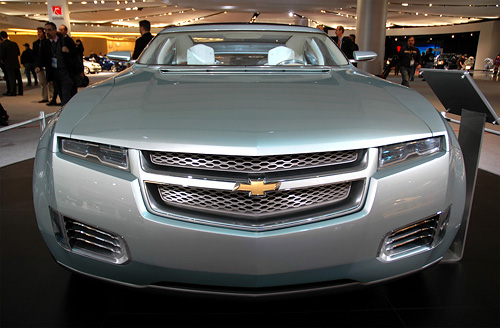
By Andrew Liszewski
When the Chevrolet Volt concept was revealed at last year’s NAIAS it not only made headlines in the major automotive publications and websites, but throughout the gadget and technology blogging community as well. Normally you have to stick a 32-inch LCD TV in the trunk of a car for it to be considered ‘gadget-fare’ but the Volt stood on its own as a great piece of technological innovation. And while there’s no doubt we’ll all be driving electric cars like the Volt some day, there are still some big hurdles to overcome before that’s a reality.
As much as I’d like to walk into a dealership right now and buy myself a Volt, it hasn’t officially been announced as a production vehicle just yet. While at the show I had an opportunity to speak to Tony Posawatz, the Volt’s Vehicle Line Director and Denise Gray who’s the Director of Hybrid Energy Storage Systems at GM. They both admitted that the biggest hurdle for the Volt to overcome was the current state of lithium ion batteries. A 20-hour battery life for an MP3 player might be totally acceptable, but if a larger version of that battery can only power a car for 3 miles, consumers just won’t buy it. And besides performance, there’s a long list of other issues that have to be dealt with on a battery designed to power something as large as a car. But GM has apparently been working hard with a handful of other companies to overcome these problems, and they’re confident they’ll be able to bring an affordable production version of the Volt to the masses in just a couple of years. (And by affordable I mean in comparison to expensive high-performance electric cars like the Tesla or Karma.)
But while the Volt and other hybrid vehicles will no doubt be a big step towards reducing our dependency on fossil fuels, there are still millions of vehicles on the road that exclusively rely on gasoline. It would be great if everyone was willing to just trade in their cars for a hybrid or electric model right now, but that’s simply not going to happen. So dealing with those legacy vehicles is probably the biggest obstacle when it comes to weaning the world off of gasoline.
The most popular and plausible solution to the problem seems to be the use of E85 as an alternative fuel. E85 is basically just a way to refer to fuel that is composed of 85% ethanol and 15% gasoline, and converting a traditional car to run on E85 is far easier than converting one to run on electricity. But since ethanol has been traditionally produced using products like corn, many people have feared that increased production of the fuel will in turn affect the food supply in the US.
So at the beginning of this year’s NAIAS, GM announced an interesting partnership with a company called Coskata who have developed a new process for creating ethanol from a wide range of waste products including plastic, wood, tires and other organic sources. The patented process uses just 1 gallon of water to produce 1 gallon of ethanol (compared to using 3 or 4 gallons for corn or plant based ethanol) and the production itself emits 84% less greenhouse gases than the production of gasoline. It could also result in ethanol fuel prices that are considerably cheaper than what we’re paying at the pump right now.
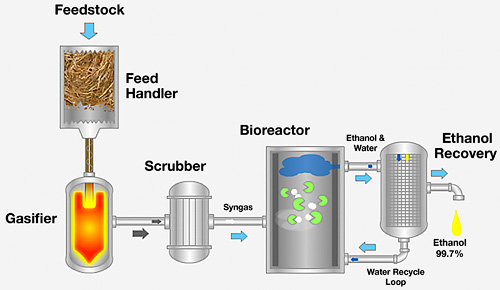
And while GM has invested in Coskata as a sign of good faith, they have no intentions of taking over the company or selling the fuel in the future. However they do realize that in order for E85 vehicles to catch on, there has to be a greater infrastructure throughout the country (and the world) to not only produce the fuel, but also distribute it to gas stations. Drivers will be more accepting of E85 if it’s as widely available to them as gasoline is now. Coskata claims they’ll have their first commercial-scale plant making 50 to 100 million gallons of ethanol by 2011 and while their claims are nothing more than great PR right now, both companies seem very excited and determined to make it work.
Admittedly, it would be great if all these innovations could be running and available as of tomorrow, but the auto industry has long since been dependent on fossil fuels, and moving away from this dependency will unfortunately take some time.
But what about right now? I have to admit it was a bit odd sitting at the press conference for the Coskata announcement in a huge booth, surrounded by massive TV screens and a lighting grid that would rival any broadway production. While the announcements from all the companies about their eco-friendly initiatives were great, the elaborate booths and over the top stunts made you wonder if they were really gung-ho about the whole ‘going green’ idea.
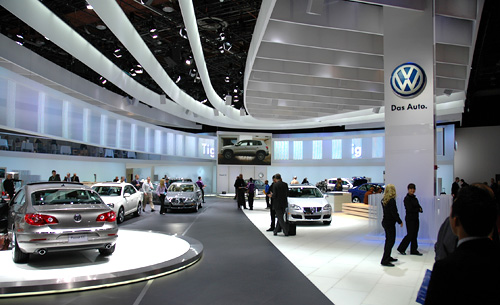
Now don’t think I’m specifically picking on VW here, this is just one of the photos I took that had a good view of the overhead lighting in the booth. And as someone who’s worked on TV and stage productions, I know this type of lighting isn’t exactly energy efficient. Another thing I unfortunately didn’t notice until I got home (and Joel Williams from Life Goggles mentioned it on his blog ) was the complete lack of recycling bins at Cobo Hall. With all the pop cans and water bottles that were given out during the press days, you’d think there would have been more of an effort made to recycle the empty containers.
So while I’m not saying that the auto manufacturers should forgo the fancy lighting and eye-catching booths, I just think it would go a long way in the eyes of environmentally conscious consumers if the exhibitors did things like switch to LED lights, built their displays out of recycled materials or even put out easy to find recycling bins. In fact if they went out of their way to publicize a green booth I think it would generate just as much good PR as the green vehicles themselves.
One last thing I want to briefly touch on concerning the NAIAS is the whole bloggers vs. journalists debate. At trade shows like CES or the once great E3, bloggers are treated just like any other members of the press. (Give or take.) But from my own experience the NAIAS in Detroit hasn’t quite accepted the blogging community just yet. Now I don’t know the exact reasons behind this, I’m sure a lot of it comes from pressure from the automakers who are exhibiting, but besides the social media group invited by GM, I saw very few other bloggers during the press-only days.
Needless to say any bloggers who did make it in weren’t exactly at the top of the list when it came to scoring interviews with industry executives. So I’d like to thank GM again for giving all of us in attendance the opportunity to speak with so many people at the company. In fact the highlight of this year’s show for me was the private Q&A sessions GM arranged for us with both Bob Lutz (General Motors Vice Chairman) and Rick Wagoner (General Motors Chairman and CEO.)
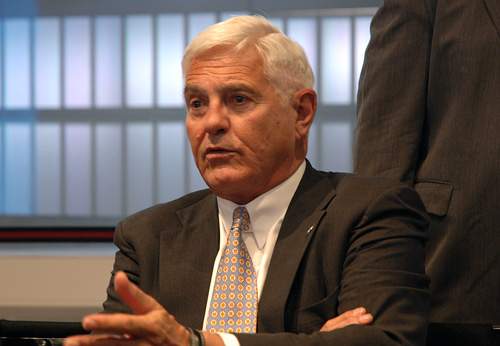
Bob Lutz (General Motors Vice Chairman)

Rick Wagoner (General Motors Chairman and CEO)
As bloggers, these sessions were definitely a rare opportunity, and I think the group represented itself well with the types of questions that were asked. Basically none of that “What kind of car do you drive?” crap. Now don’t get me wrong, I’m not blind to the fact that these interviews also provided General Motors with some great publicity in the blogging community, but the bottom line is that they went out of their way to give us access to a lot of people we normally wouldn’t have had a chance to talk to. No other car company at the show was as accommodating. (Well, Lamborghini did go out of their way to prevent Paul Stamatiou from sitting in the Murcielago LP 640 Coupe they had on display.)
In the gadget and gizmo community, a lot of people consider Joel Johnson’s interview with Bill Gates back in 2005 to be the point when technology bloggers (or really bloggers in general) started to be recognized as valid journalists. And while Rick Wagoner might not be as recognizable as Bill Gates is, I couldn’t help but feel that our Q&A with him was another step towards bloggers being taken more seriously in the corporate world. If you’d like to watch the bloggers interviews with Bob Lutz or Rick Wagoner I recommend checking out the videos of both events graciously provided and hosted by Matt Kelly at NextGear.
Disclaimer: In case you missed my original post, GM has requested that I disclose the fact they covered my airfare and accommodations for the show.




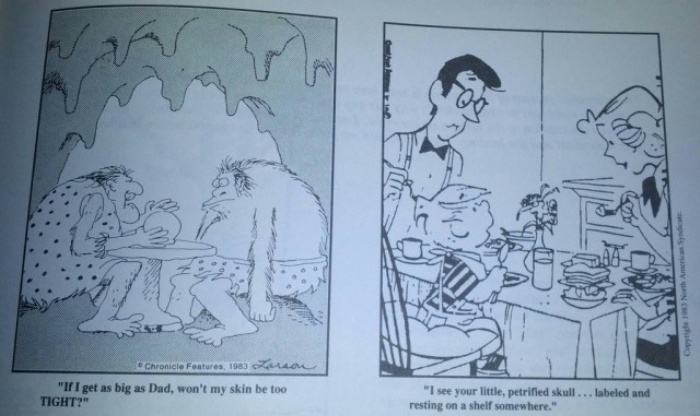
Seems you drink every drop of GM’s propaganda kool aid! They already had a battery rated at 350 miles but they sold the rights to an oil company. Just part of their keeping alternatives just out of reach program. Remember all those electric cars GM leased and then took back because they worked too well and didn’t require lots of parts and maintenance? Of course taking them back and refusing to release them was only part of the plan. The rest was to crush all of the cars into oblivion even though they were all virtually new. By the way, what would an oil company do with the rights to a battery? Think about it.
I don’t care how concerned or devoted GM looks to alternatives on their commercials, they along with the other car companies and big oil are going to attempt to keep us dependent on oil until every last drop is gone! And with plenty of sheeple out there that believe everything told to them I’d say they will have no trouble.
I’m just reporting what I saw at the show. Like I said, so far the Volt is nothing more than a concept car, and the Coskata announcement is just an announcement. It would be great if they eventually both came to fruition, but it’s not going to be anytime soon.
And I do remember all those electric cars that required people to install special chargers in their garage, and worked great in warm climates like California. But I can’t help but feel the EV1 wasn’t exactly the perfect solution for the rest of the world. Maybe I’m just not drinking enough of the ‘Who Killed The Electric Car’ Kool-Aid?
“…It would be great if everyone was willing to just trade in their cars for a hybrid or electric model right now…” do you have any idea what that would do to the electrical grid? Can you imagine million upon millions plugging their car in during the summer time? POW! Rolling black outs. POW! Look at your utility bill! We are going to have to ease into this, it’s not going to be solved by making sun roofs into solar panels.
Ha… Yeah that’s another good point. People seem to forget that the electricity needed to recharge electric cars has to come from somewhere. I have to admit it was disappointing seeing another auto show come and go without anyone announcing a Mr. Fusion option. Some day…. some day….
“If PHEVs found widespread adoption, demand doesn’t seem to be a problem. The joint EPRI-NRDC study found that even with a 60 percent U.S. market share, electricity consumption would rise only 7 percent to 8 percent in 2050.”
http://uaelp.pennnet.com/display_article/307868/34/ARTCL/none/none/1/Save-the-World,-Make-Millions-Here%E2%80%99s-How/
MCMAN get a life. what do you have to do with the decisions of a company. the corporation can do what they want with their property. if you dont like what they are doing get off your lazy but and do something about it. create your own ideas. get your own car company. if you dont like oil then dont use any and stop buying it but dont bitch about the things you use. your hypocrisy is sickening to us all.
MCMAN you are a hgoof stop driving cars and stop using oil moron
MCMAn get a life stop using oil and stop driving cars moron. invent something already
MCMAN get a life. what do you have to do with the decisions of a company. the corporation can do what they want with their property. if you dont like what they are doing get off your lazy but and do something about it. create your own ideas. get your own car company. if you dont like oil then dont use any and stop buying it but dont bitch about the things you use. your hypocrisy is sickening to us all.
MCMAN you are a hgoof stop driving cars and stop using oil moron
MCMAn get a life stop using oil and stop driving cars moron. invent something already